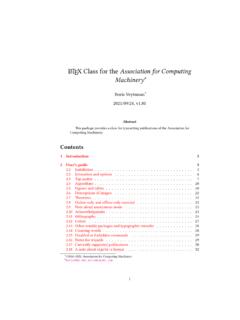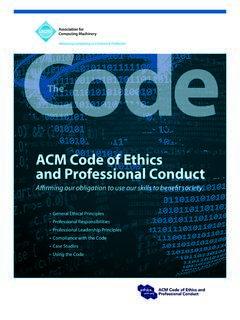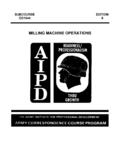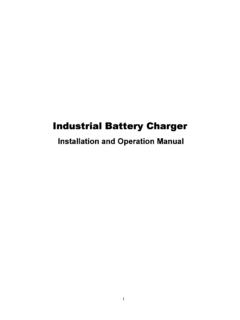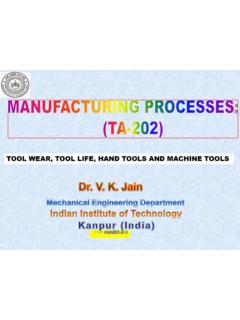Transcription of acm master article template instructions
1 instructions for Applying the Primary article template TO YOUR ACCEPTED ACM SUBM ISSION DOCUMENT Congratulations on having your paper accepted for publication in an ACM venue! The ACM Primary article template is an extension of the ACM Submission template . Applying the Primary article template to your approved submission document is the final step you will take before submitting your article for publishing within an ACM journal or conference proceeding. This document will provide a short checklist of tasks that you are required to complete before submitting your article to an ACM publishing venue. Please remember to save as you go! Attaching the ACM Primary article template Download the ACM Primary article template ( ; Mac or Windows) from to your machine andextract the zip file.
2 Open your accepted Submission Document. Attach the file to your Submission Document by doing the following:Attach the template for the appropriate version of MS Word as shown below: oWord 2007: Press the Windows button at the top of MS Word and click Word Options; oWord 2010 and above: Click on the File menu and select Options, which then opens the WordOptions dialog box: Select Add-Ins in the Word Options dialog box. Click on the Manage Drop Down list and select Templates. Click the Go button. The Templates and Add-Ins dialog box MAC: Go to the Tools menu: Click on Templates and Add-Ins option. To select the relevant template , click on the Attach button. Word will display the AttachTemplatedialog box, which works like the Open dialog WINDOWS Select the template from the respective location where you have downloaded the template from ACM website and click on the Open button.
3 In Templates and Add-Ins dialog box, click OK. The styles (including macros) stored in the selected template are now available in your document. (Note: If you get the security warning Macros have been disabled, select Enable Content. ) Once you have successfully attached the template , the word menu bar will have additional menu options added ( Reference and Crosslinking and ACM Templates .) FOR MAC View Your Document in Draft Mode We strongly recommend that you work in draft view. [Click the View menu and select Draft option] so that you can simultaneously view and verify applied styles for section(s) of text you are working with. The Style panel should appear on the left-hand side of the Word File.
4 If it does not appear on the screen even after applying the draft view, then please refer to the submission template instructions regarding how to view the document in draft mode. Now the paper should be in draft view with the style panel on the left-hand side of the document. All the paragraph styles are available in the Style Pane as well as in customized menu bar (under Head Elements and Body Elements in the toolbar/ribbon). It is mandatory to apply the appropriate style to all the text elements in your paper to avoid errors when submitting for publication. Check Paragraph Styles and Supply Alt Text for Figures and Tables Review each element in your paper to ensure that the correct style has been applied to the respective element before moving on to the next steps.
5 (Please refer to the submission document instructions if needed for instructions on how to apply the styles to your text.) Insert alt text (descriptive text) for any non-decorative figures and tables in your article . (Please refer to the submission document instructions if needed for instructions on how to insert alt text to your figures and tables.) Insert your ORCID iD We strongly recommend that you insert your ORCID iD number. [If you do not have an ORCID ID you may apply for one at ] How to insert your ORCD in your document: The template has an option to insert your ORCID under the Head Elements ribbon. Highlight the author s name in manuscript (that has the registered ORCID) and then click the ORCID button in the ribbon.
6 A prompt appears (as seen in the above screenshot) with the selected text to add the ORCID value. Insert the ORCID and select the OK button. How to view your ORCID: Verify the ORCID value by navigating to: INSERT (from the top menu)--> Bookmark. ORCID will be available for review as ORCID_ (count) _ORCID value ( ORCID_1_1234567890, ORCID_2_xxxxxxxxxxx) Prefix = ORCID (fixed text) Count= Sequence number of inserted ORCID. ORCID value= actual ORCID value This value will appear in published HTML output of your paper; will also be included on your ACM Author Profile Page. Run ACM Primary article template Macros Once you have verified that the correct paragraph styles have been applied to your text, please do the following: Reference and Cross Linking: There are two types of reference formats: 1) numbered and 2)author year.
7 If your article uses the numbered reference the Reference and Cross Linking menu, under Cross-referencing select Float and Bibliography. first message prompt that will be displayed will ask you to confirm that the reference endposition is correct and to select yes if it is, otherwise select no to fix second message prompt will ask you to choose the reference type you used in yourarticle type 1 for the numbered reference style or type 2 for the author year your article uses the author year reference style, then individual reference marking is mandatory for the author s name (surname, first name) and the year before running the Reference and Cross Linking macro otherwise it will prompt an error message during Manuscript Validation.
8 In the author year style references, the author s name must have these character styles applied: FirstName, Surname, and then have the style AuthGroup (a dotted boundary) applied to the entire name. You can then run the macro as per the steps outlined above. We find it useful to execute these steps to set up the citations correctly: the authors and year in each the macro, which generates the and paste each label where the citation occurs. Cross Linking: The Float and Bibliography macro will also cross link all the float elements (figures,tables, ) and the bibliography elements with their citations. This macro generates autolabeling to link the citations If author-year citation is like [name, year] in the body text, then thegenerated labels must be the same as the corresponding citation.
9 When it is completed correctly, youwill receive a message prompt stating that the process completed successfully. (Please give themacro a few minutes to run as Word may appear/state that it is Not Responding.) The Fundref data option marks all funding sponsor information with its specific number. Manuscript Validation: After you complete the above steps, run this macro (found under the ACMT emplates menu) to check for any errors in the document. If your document does not have any errors,you will receive a message prompt stating that the process completed successfully. If yourdocument has any issues, error or warning alert messages will appear to prompt you to correct what isneeded. Re-run the macro until it states that the process completed successfully.
10 WHEN THE MANUSCRIPT VALIDATION IS COMPLETED, THE NEXT STEP IS TO SUBMIT YOUR PAPER TO THEACM PUBLISHING SYSTEM WHICH WILL FORMAT YOUR article AS PER THE SPECIFICATIONS OF YOUR ACM VENUE.
